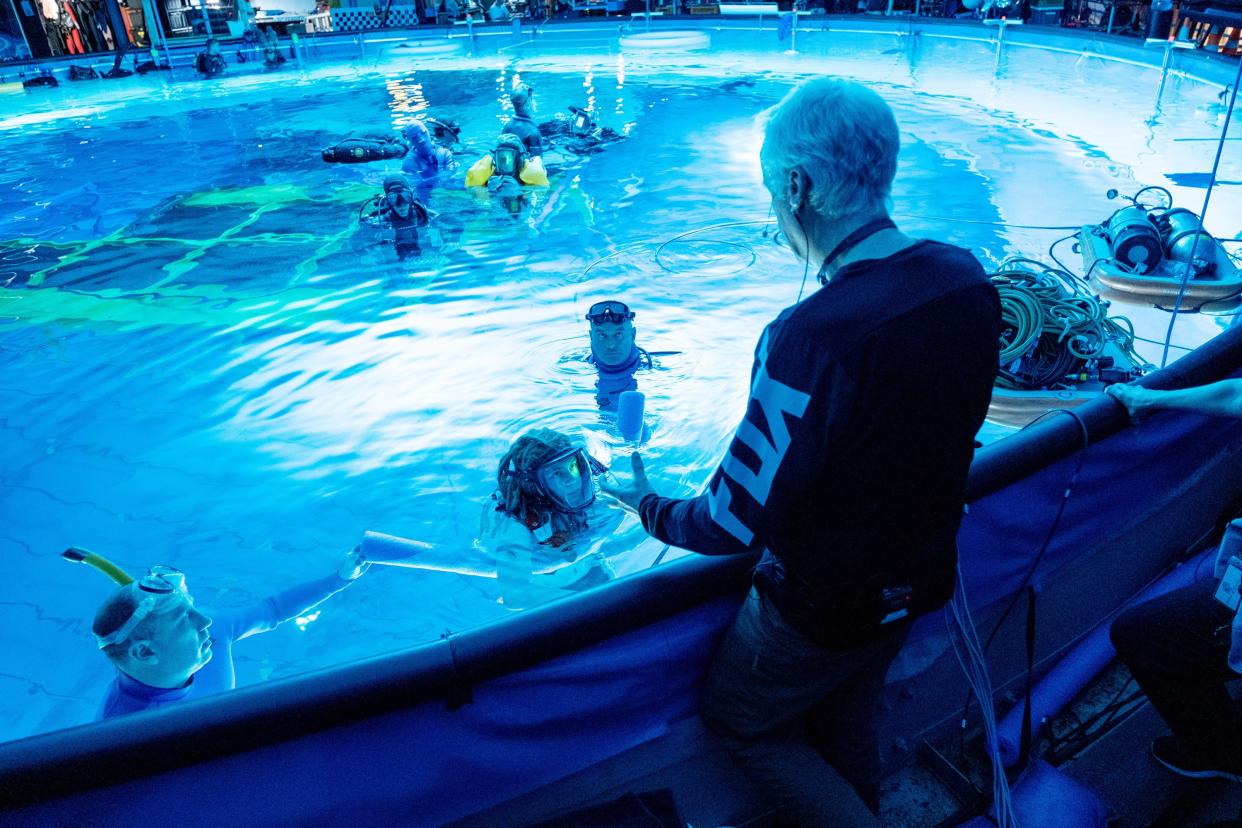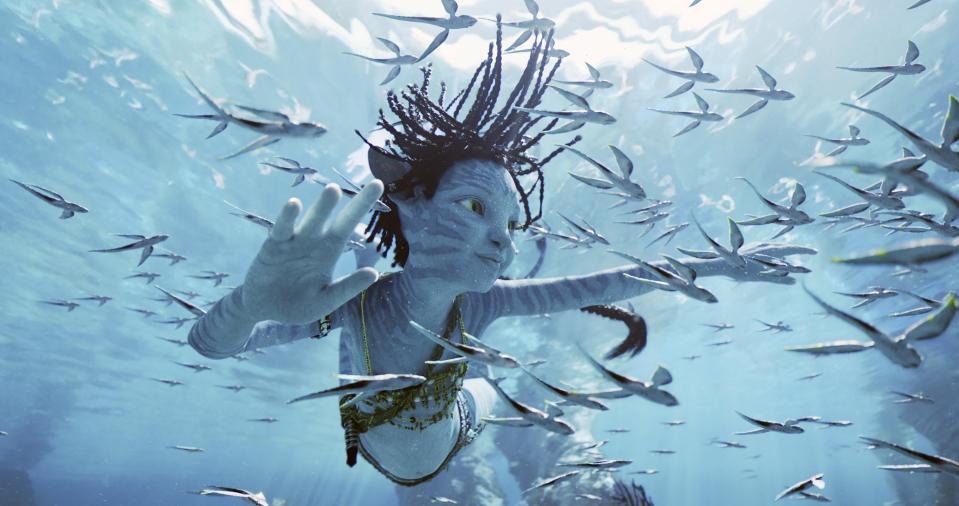‘Avatar: The Way of Water’: How They Shot the Breathtaking Underwater Footage

Underwater director of photography Peter Zuccarini first ingratiated himself to “Avatar: The Way of Water” director James Cameron by finding a straightforward solution to a difficult problem in their first interview. The director and his team had been wrestling with how to shoot performance capture underwater when the bubbles from scuba gear interfered with the markers on the actors’ bodies and faces. “He had been working on all these incredibly interesting technological solutions,” Zuccarini told IndieWire, “but when he explained to me that the actors would be training to do long breath holds so that they could perform underwater I said, ‘Well, if the actors are doing breath holds why don’t we do breath holds with them and avoid the limitations of technology? We’ll just assemble a team of world-class freediving cameramen.’”
Zuccarini has long been the go-to cameraman for filmmakers who need difficult underwater shots – he was dragged by a shark while filming “Into the Blue” and ventured into a crocodile-infested section of the Amazon (rumored to be cursed by locals) for “The Motorcycle Diaries” – but nothing in his career prepared him for the sequel to Cameron’s groundbreaking science-fiction epic. While Zuccarini has found that on most shoots there’s always a limit to what can be done given time and money, in Cameron he found a director unique in his refusal to settle. “With the specificity of someone like Jim, it has to be exactly what he imagines or better,” Zuccarini said. “It takes a long time because there are no compromises.”
More from IndieWire
James Cameron: 'Every Take Is a Blank Slate' in the Virtual World of 'Avatar'
A Moviegoer's Guide to the Many (Many) Ways to See 'Avatar: The Way of Water' in Theaters
When Zuccarini says that it takes a long time, he isn’t kidding — what was supposed to be a two-month job ended up lasting for four years off and on due to the complex nature of the production. The film expanded on the performance capture technology developed for the original “Avatar,” taking it underwater for the first time. That involved hundreds of cameras and markers tracking every detail of the actors’ expressions and movements for Cameron to mold in post-production, where he would choose his angles and compositions using a virtual camera. But the director still wanted a real cameraman with a real camera in the tank with the actors so that there would be a baseline of reality to work from as the actors rode mockups of various sea creatures and fought in the water. “He did not want any performance to not actually happen in real water,” Zuccarini said. “He wanted to make sure that the physics of the movement underwater were always correct.”
This allowed Zuccarini to take his camera — a 180-pound 3D Sony Venice developed specifically for “Way of Water” — into the water with the actors instead of shooting from outside the tank through windows. “A camera in the water has much better optics because of refraction — you can’t shoot an angle through windows properly.” Shooting with the massive rig — which was actually two Venices in a box shooting through a beam-splitter — created its own challenges and limitations. “In the water the 180 pounds are neutral, but it’s still 180 pounds of water volume, and it has inertia,” Zuccarini said. “So if Jim says, ‘I want you to swim this way, then I want you to go up, and then I want you to come back the other way,’ well, a 180-pound camera wants to keep going the one way.” Therefore, shots that under normal circumstances would have been accomplished by Zuccarini handholding a modular unit required a greater collaborative effort, as grips attached lines to the camera to properly time the stops.

Walt Disney Studios Motion Pictures / Courtesy Everett Collection
The Venice rig was just one piece of equipment built from scratch for “Way of Water,” the result of months of rigorous testing and research and development. “Everything had to be designed from the ground up and purpose-built for the movie,” Zuccarini said. “There are a lot of issues with the interface of water and lenses and whether what type of port you use affects the refractive characteristics — whether it magnifies or gives you back the true field of view — and then what distortion or color aberrations come with those optical elements.” Cameron and his team spent extra time on the front end in the hope that the technology would endure throughout the process of shooting four sequels back to back. “[The idea was to] really future-proof ourselves across the whole oeuvre of films,” Cameron told IndieWire. “I’d rather stop once for a big chunk and get it all ready and then work with a kind of rhythmic cadence forward from there where we don’t have to stop and retool at each stage of the game.”
The process of shooting underwater performance capture and marrying it to real elements shot in front of a blue screen gave Zuccarini his greatest challenge, which was taking the camera moves he created in a tank in Manhattan Beach throughout an 18-month shoot and then recreating them halfway around the world at WETA’s visual effects house in New Zealand. At times he questioned his own contribution to the film given the fact that so many decisions were being made in post-production. “We’re all just contributing pixels and data for Jim to stir up in the soup,” he said. “When we went to the Bahamas, for example, Jim sent me out with a list of things he wanted to see in 8k, so I went out with a camera and I shot in different swell and wave states the saltation process, where sand lifts off the bottom and then settles into little rippled patterns. We were shooting with the same care that I shot the plates on for the ‘Pirates of the Caribbean’ series that were actually used in the movies, but here it’s really just being ingested by Wētā as reference material.”
“It made me feel pretty redundant at times, like I was informing some things but more just confirming that their math was working for how they would build that water,” Zuccarini continued. Yet ultimately he realized that his camera movements were impacting the finished film in much the same way as the actors’ performances — in fact, markers were put on Zuccarini and his camera just as they were on the actors so that Wētā could recreate his movements with precision. “Just as the stunts have to be right in the physics of the water, Jim doesn’t want the camera to move in a way that it couldn’t, because it would throw you out of the movie. So when they were building shots digitally they were going back and taking my camera moves instead of making them from scratch, because it was easier for them to design.”
The result of Cameron’s approach is a wholly new cinematic experience, and Zuccarini said that’s by design. “Jim is a creative guy who wants to innovate in every aspect. The camera has to move in a way it has never moved before. The light has to do something it’s never done before. In every frame he puts a lot of pressure on himself to really be on that bleeding edge — are we doing something fresh here? So you come to work and every day is super, super intense and you’ve got to go for years like that.”
Best of IndieWire
New Movies: Release Calendar for December 16, Plus Where to Watch the Latest Films
Sundance 2023 Movie Deals So Far: Paramount and Netflix Bite First
Sign up for Indiewire's Newsletter. For the latest news, follow us on Facebook, Twitter, and Instagram.

 Yahoo News
Yahoo News 
